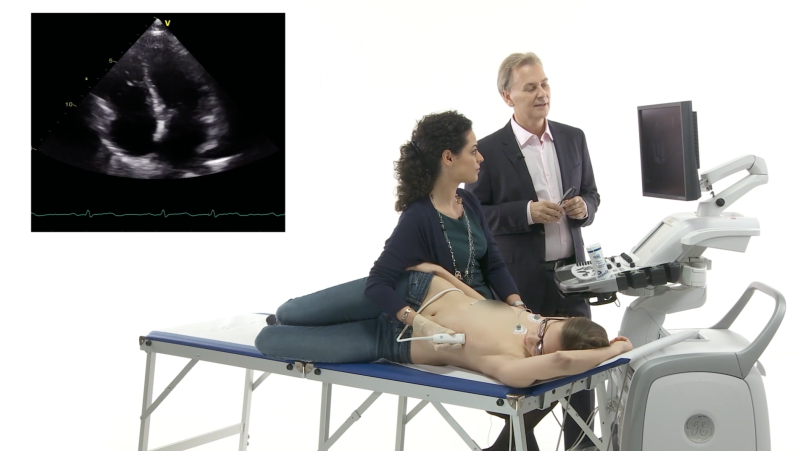Small is beautiful
We do live in a world where size matters: a bigger car, a larger house, a bigger television screen, or simply more delicacies on your plate. But do things always have to be large? Don’t forget: sometimes the best gifts come in small packages. This is also true of echocardiography. Read on and find out what I mean.
Chest pain
A 70-year-old patient was admitted to our emergency department with chest pain. He had experienced severe pain in the mid-chest about one hour earlier, radiating to the neck and back, accompanied by nausea. His hypertension was under treatment with an ACE inhibitor. In the emergency room his blood pressure was 130/60 mmHg. A faint diastolic murmur was heard at the base of the heart. The initial ECG showed sinus rhythm at a rate of 60 bpm without ST segment elevation. Non-STEMI, right? True: his pain subsided after standard medical treatment including nitroglycerin. His blood test was normal and the high-sensitivity cardiac troponin assay was negative. The patient was transferred to the coronary care unit, awaiting a coronary angiography to be performed the next day. It seemed another boring non-STEMI case.
Are you sure curiosity killed the cat?
I was the cardiologist on duty that day and was at the coronary care unit, attending another patient. After I had completed my work I looked around to see if there were any other interesting or unusual cases. I started reading the charts when something caught my attention. It was the non-STEMI case. I asked the patient about his symptoms and then performed an echocardiogram using the pocket-sized echo I usually carry during my cardiology shift. Left ventricular function was preserved and he had no segmental wall motion abnormalities. He had mild aortic regurgitation. What really caught my attention was a very large aorta.
Something was moving around in the aorta, and it was not the aortic valve. What additional information would color Doppler provide?
Color Doppler helps to distinguish between the true
and the false lumen.
Blood flow does not reach the rim of the aorta. Why? Because of an intimal flap that dissects the proximal ascending aorta into a true and a false lumen.
The chest X-ray performed earlier was available right then:

Portable chest X-ray. Hmm!
The mediastinum is broad. Now the pieces of the puzzle suddenly fit together: aortic dissection indeed. Let's take a closer look. From a suprasternal window one could see the intimal flap in the aortic arch. By the way, if you suspect a dissection this view is mandatory. After all, the intimal tear frequently occurs at the concavity of the aortic arch, close to the origin of the subclavian artery.
Suprasternal view showing the aortic arch and the
intimal flap.
Color Doppler view of the aortic arch.
Time for big machines
Transthoracic echocardiography is quite useful to visualize dissections in the aortic root, the caudal part of the ascending aorta, and parts of the aortic arch. However, to see more of the aorta we need TEE. Now it is time for the “big” machine with all the advantages of a high-end scanner, including spectacular image quality. These are the images we obtained:
Long-axis view of the ascending aorta. Clearly there
is dissection here.
What information do these images provide? First, the entire circumference of the aortic intima is dissected. The aorta looks like a “tube in a tube,” with the false lumen partially thrombosed. A thrombus in a false lumen is usually indicative of a blind sack in the false lumen. In other words, the entry site into the false lumen is rather distal to this location. This is also confirmed by the contrast study. We did not see any contrast passing from the true into the false lumen in this region. This was confirmed on color Doppler:
When investigating dissections of the ascending aorta, special attention should be given to the aortic valve:
Mild to moderate aortic regurgitation.
Obviously, the patient has mild aortic regurgitation. In other words, the dissection does not involve the aortic valve - a source of great relief for the surgeon.
…. and an even bigger machine
As the patient was in stable hemodynamic condition, we performed a CT scan prior to surgery. I considered this a good idea because CT may well provide additional information. In many countries CT is given preference over TEE for the detection of aortic dissection.

CT scan: ascending and descending aortic dissection.
A classic type A aortic dissection affecting the ascending, descending, thoracic, and abdominal aorta. The diameter of the ascending aorta was 65 mm while that of the descending aorta was 37 mm. Again, note the circumferential dissection of the ascending aorta.

CT scan: dissection and aortic dilatation at the aortic arch.
In fact, CT did provide additional information: the dissection extended into the brachiocephalic and right carotid artery. The subclavian arteries and the left carotid artery were normal.
Don't forget the basics
This case teaches us several things. First, small is really beautiful, especially in the setting of emergency medicine. Pocket-sized scanners might have limited technical capabilities, but are sufficient to detect some important facts. I think they should be used as a complement to the physical exam. Second, ultrasound established the diagnosis long before the chest X-ray or CT did. Pull the hand-held ultrasound out of your pocket and there you go. Finally, consider aortic dissection in patients with chest pain. Evaluation of the aorta is a routine part of the echocardiographic examination, especially in patients with acute chest pain. Actively look for dissection. Pay attention to aortic root dilatation, aortic regurgitation, and pericardial effusion. While a negative TTE does not entirely rule out aortic dissection, it can provide important clues that will lead to further tests such as TEE or CT.
Our experience with pocket-size echo
We've been using pocket-sized echocardiography in our cardiology shifts for more than two years. We cannot envisage working without them. Considering the size of the device, its image and Doppler quality is really good. One can even perform simple measurements.The limitations are obvious: no CW, no PW, no M-mode, and a small screen size. It cannot replace a standard echocardiogram when it comes to making a more refined diagnosis. Compare it to a stethoscope. What provides more information? If you extend the potential applications to other areas of medicine you end up with a much more powerful device - not only for the cardiologist but also for emergency medical physicians, anesthesiologists and internists. There is only one drawback: you need to know more about echo and ultrasound. Isn't this the “killer argument” to enroll to our 123sonography Masterclass?

Best,
José Carlos
PS: If you want to learn more from José Carlos, take a look at his “dragon case”.
PPS: Dont forget to like us on Facebook !


